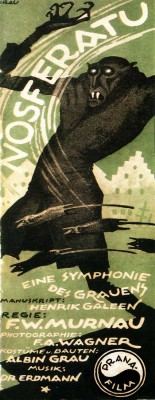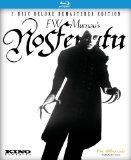| Reviews & Columns |
|
Reviews DVD TV on DVD Blu-ray 4K UHD International DVDs In Theaters Reviews by Studio Video Games Features Collector Series DVDs Easter Egg Database Interviews DVD Talk Radio Feature Articles Columns Anime Talk DVD Savant Horror DVDs The M.O.D. Squad Art House HD Talk Silent DVD
|
DVD Talk Forum |
|
|
| Resources |
|
DVD Price Search Customer Service #'s RCE Info Links |
|
Columns
|
|
|
Nosferatu
But then around 1994 I was a Master's student at the University of Southern California's School of Cinema-Television, in a class where instructor David Shepard, the eminent silent film historian and preservationist, ran a beautiful 35mm print, projected at the proper speed (a particular obsession with Shepard) with live organ accompaniment. That screening was a revelation, the film's great artistry instantly apparent. What had been eye straining and rather comical before was now impressively eerie. Only then did I realize just how influential yet also way ahead of its time the film was.
The Blu-ray format provides viewers with a similarly ideal venue to experience silent films. Movies like Intolerance, The Thief of Bagdad, The General, and City Lights have never looked better. They now come darn close to replicating the viewing experiences of their original audiences, and sometimes the restoration efforts produces results so sharp and richly detailed that it's hard to believe many of these movies are nearly a century old.
Kino's new release of Nosferatu sources an extensive restoration undertaken by the Friedrich-Wilhelm-Murnau-Stiftung, which mainly utilizes a 35mm German theatrical print, with missing or unusual sections derived from myriad other film archives, resulting in the best-looking, most complete Nosferatu ever.
Granted, the film elements sourced are clearly worn, rife with very fine scratches throughout. Unctuous critics, the kind who find fault with most every Blu-ray release, bellyache that Kino should have taken the restoration one step further by digitally cleaning up these imperfections. (I dare say if they had, these same people would have complained about the absence of these same imperfections.) Anyway, don't listen to them. For starters, the scratches are hair-thin for the most part and never any real distraction. It's a film transfer that looks like film, not super-scrubbed video, and the crispness of high-def-rendered detail is astonishingly good. Further, the presentation includes an excellent reconstruction (by Berndt Heller) of Hans Erdmann's original 1922 score, which adds immeasurably to the presentation.
A 2-disc set, Kino's release offers the movie in two forms, with English intertitles on Disc One, and German intertitles on Disc Two. The latter version, supported by English subtitles, is definitely the way to see the film. The bit rate is slightly higher on the German version, it includes all the original German footage (diary pages and other insert shots.) and, hey, you're going to be reading intertitles either way, so why not watch the film in its original form?
Nosferatu famously plagiarizes Bram Stoker's Dracula. A lawsuit resulted, and all prints in circulation in the United Kingdom were ordered destroyed. However, the court ruling didn't extend to other parts of the world, which is why the film still exists today. (The often-erroneous Wikipedia suggests a single copy of the film survived. Not true.) The movie follows Stoker's novel very closely in its first half: Hutter/Harker's journey to the Carpathian Mountains in Transylvania to close the sale of property back in Germany/England, his early encounters with the blood-sucking Count Orlok/Count Dracula, the horrifying sea voyage during which Orlok, smuggled aboard in a coffin (one of several containing his undead-sustaining native soil), murders the entire crew, etc.
That sea voyage to Germany/England typically lasts all of 60 seconds in most film versions, but it's a major set-piece in Nosferatu, and where the ship usually reaches its destination about a third of the way into most film adaptations (such as the 1931 Dracula), the picture is more than two-thirds over by the time the schooner reaches port.
Nosferatu deviates from Dracula in many significant ways. Instead of the exotically handsome if aloof foreigner of the Bela Lugosi/Christopher Lee years, Count Orlok is closer to Stoker's original interpretation, but more important than that, is a grotesque: emaciated, light bulb-shaped head, long, bony features, sunken, shark-like eyes. DVD Savant, in his review, likens his appearance to that of an insect, "a human tick, a walking leech," but I'd argue that Murnau is deliberately linking Orlok to the plague-carrying rats who figure so prominently in this version (as well as in Werner Herzog's superb 1979 remake starring Klaus Kinski, Nosferatu the Vampyre, which intelligently expands upon Murnau's original ideas while adding several good new ones). Even Savant, in his review, indirectly recognizes the connection, noting Orlok's singularly "rat-like teeth."
That Orlok unleashes the plague in Transylvania and later in Germany, it seems to me, is a direct reaction to the three-year-long influenza pandemic of January 1918-December 1920, ending only a year before Nosferatu went into production. Killing up to 100 million people, 5% of the entire planet's human population at the time, the pandemic was particularly hard on Germany, and may have even tipped the scales during World War I.
In both Nosferatu and Herzog's remake, the adaptation jettisons all concepts of the vampire as a symbol of unholy evil against which only Christian iconography and virginal purity can vanquish. Instead, Orlok is like the Pied Piper of Hamelin in reverse, luring infested rats into its storybook German city. Murnau's shifting the locale from London to Germany, from the rapidly modernizing urban London of the 1890s to German city of the 1830s, may have been a budgetary consideration but probably not. Many German films (such as their Edgar Wallace movies) are set there. Murnau was after something quite different.
Though made in 1922, the film nonetheless has a strong natural visual connection to the 19th century, even an earlier 19th century of the late 1830s. The locations add a visual verisimilitude that would have been difficult, though not impossible (as Herzog proves; he's a master of historical environments), to recreate in the years to follow. So, partly, Nosferatu is amazing as a look back at a Germany of 90-plus years ago, but also into what feels like an authentic glimpse back another 90 years.
Nosferatu was nearly the first horror film of its kind, setting a high bar that influences the genre even now, and in some respects is more cinematic than the stagy, early-talkie Dracula with Lugosi, or the mostly studio-bound, art department created worlds of horror movies to follow. Ellen, the Mina character (or Lucy, depending on the film) is both virginal and drawn to forbidden writings about Nosferatu like a ‘60s housewife surreptitiously reading a sexually explicit novel. She knows what Orlok's desires are all about, and her suicidal gesture to try and stop him as the rest of the plague-stricken city stays tightly locked up in their homes is like a proto-feminist act of assertiveness.
Video & Audio
Despite the presence of innumerable razor-thin scratches throughout and other wear (see above), Nosferatu looks quite spectacular, especially for a relatively early silent facing court injunctions and, later, the near-destruction of Germany during World War II. The image fluctuates between pretty good and excellent, mostly the latter. The 1.33:1, 1080p image is paired with the original score, reconstructed and available in both 5.1 Surround and 2.0 stereo. It sounds great. Again, I strongly prefer the German version on Disc 2, with the English-only edition on Disc 1 almost a pointless addition. Both discs are Region A encoded.
Extra Features
Supplements include an excellent 52-minute documentary on the making of Nosferatu called The Language of Shadows (2007). There's a nicely organized Image Gallery, and excerpts from eight other Murnau films: Journey Into Night (1920), The Haunted Castle (1921), Phantom (1922), The Finance of the Grand Duke (1924), The Last Laugh (1924), Tartuffe (1925), Faust (1926), and Tabu (1931).
Parting Thoughts
The best version of Nosferatu yet available, this is a must, a DVD Talk Collector Series title.
Stuart Galbraith IV is a Kyoto-based film historian whose work includes film history books, DVD and Blu-ray audio commentaries and special features. Visit Stuart's Cine Blogarama here.
|
| Popular Reviews |
| Sponsored Links |
|
|
| Sponsored Links |
|
|
| Release List | Reviews | Shop | Newsletter | Forum | DVD Giveaways | Blu-Ray | Advertise |
|
Copyright 2024 DVDTalk.com All Rights Reserved. Legal Info, Privacy Policy, Terms of Use,
Manage Preferences,
Your Privacy Choices | |||||||














